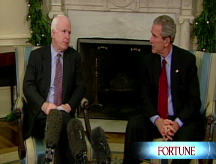Manufacturing index contracts
Survey of purchasing managers shows some lowering of prices, but overall factory activity fell in August.
NEW YORK (CNNMoney.com) -- A key measure of the nation's manufacturing activity fell in August, reaching a level that indicated contraction in the sector even as falling oil prices helped lower some business costs.
The index did not fall as much as economists had expected, and the report showed the first signs of lower prices although they remain at an inflationary level.
The Institute for Supply Management's (ISM) manufacturing index fell to 49.9 in August, down from the July reading of 50. Economists were expecting a reading of 49.5, according to a consensus estimate compiled by Briefing.com.
The tipping point for the index is 50, with a reading below that reflecting contraction in factory activity. A reading of 41 marks a recession.
The slight drop in the August report is a bad sign, said Robert Brusca, chief economist at FAO Economics.
The report "is not consistent with a growing economy," Brusca said. "This is a neutral reading that is actually a bad reading. Under most circumstances, an economy grows. Neutral is not good."
Norbert Ore, chair of the ISM's Manufacturing Business Survey Committee, said in a statement that the report shows an easing of high prices, although the Prices Index remains "at an inflationary level." Exports orders also picked up, a key point for manufacturers as "as domestic demand remains soft for most industries."
New Orders
One of the key components of the index, new orders made a 3.3% gain in August, although with a 48.3 reading, it marks the ninth consecutive month of contraction.
Price inflation
The prices manufacturers pay for materials fell 11.5% from July, but prices continued their 20th month in an upward direction, according to the report.
The reading fell to 77 from 88.5 the month prior. That's down from June's spike to 91.5, just shy of the 93.2 record set in July 1979.
Commodities that dropped in price include copper, corn, diesel fuel, fuel oil, natural gas and soybean oil.
Employment
The index's employment measure fell 2.2% in August, a reverse from gains made the previous month. The reading fell to 49.7, from 51.9 in July. The June index for employment was 43.7.
Brusca said manufacturing employment has followed a steady downward trend since its peak in May 2004, and that the surge that occurred in July was "a very strange reading."
This month's contraction suggests that manufacturing is moving sideways, a positive sign if it suggests some stability in manufacturing employment, he said.
The Labor Department's monthly report on nonfarm payrolls comes out Friday, and economists expect payrolla to decline by 75,000.
Exports
Exports increased by 3% from July, continuing their straight monthly line of growth spanning more than five years.
The ISM's measure of exports in August increased to 57 from 54 in July. ![]()



